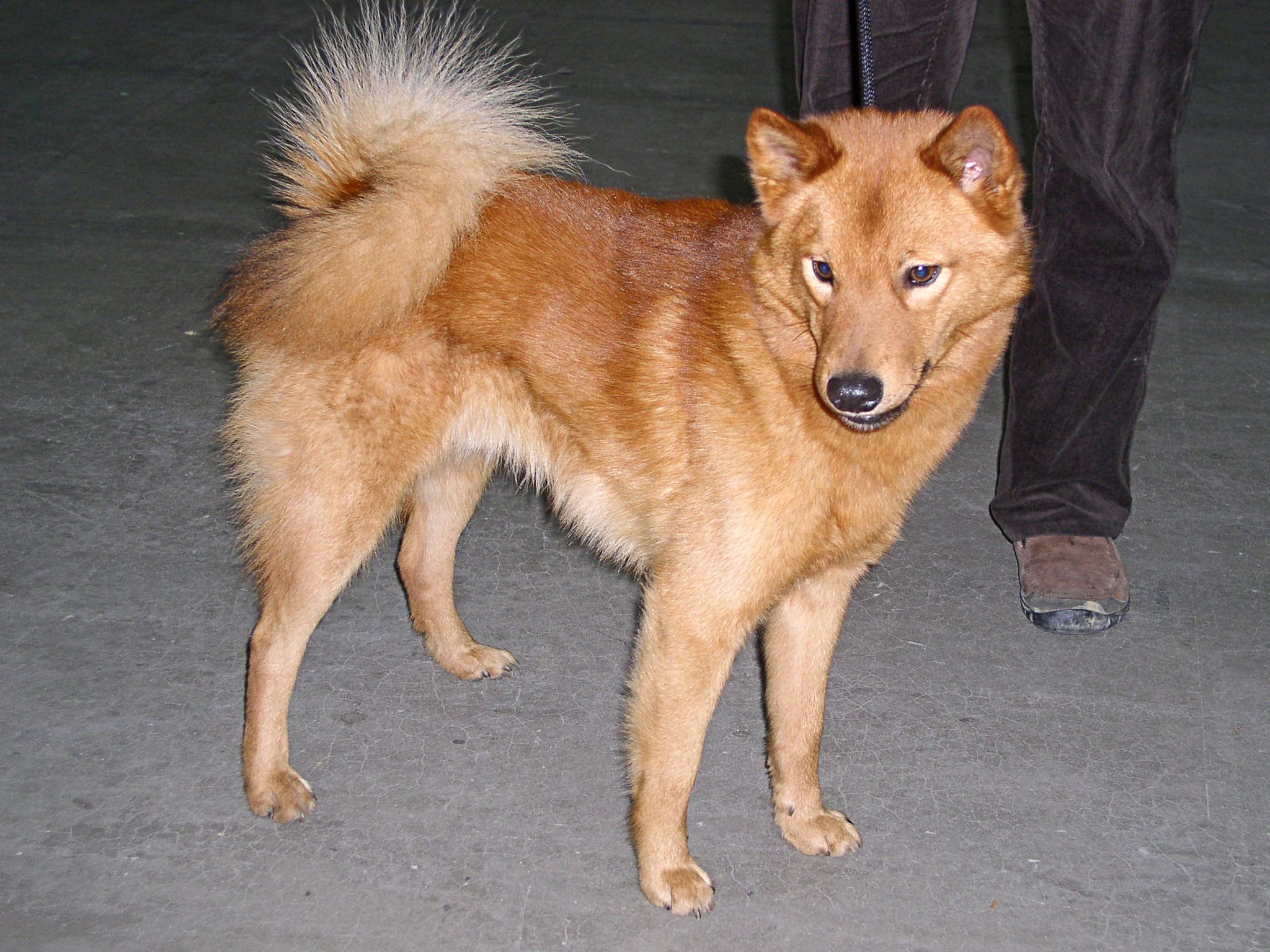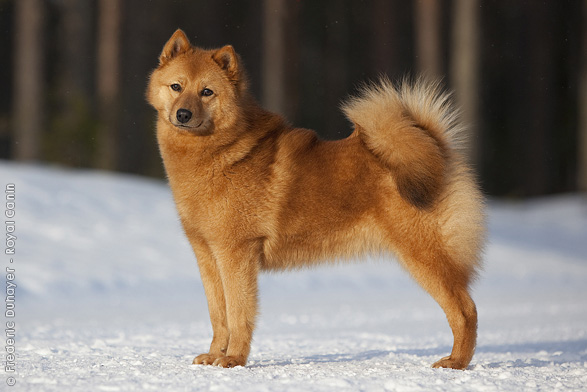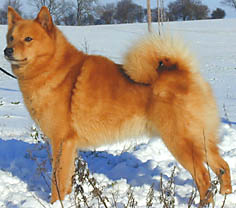
The Breed History
This is the National Dog of Finland. Several thousand years ago in
Central Russia, Spitz-type progenitor dogs such as the Russian Laika
likely served as the primary gene pool. Due to outcrossing, by the
year 1880 The Finnish Spitz dogs were nearly extinct. The final breed
standard was drawn up in 1897 (final American standard, 1976).
The first specimens arrived in England in 1927, and were exported
to the USA in 1959. AKC accepted the Finnish Spitz for registry in
the late 1980s.
Breeding for Function
Originally, the breed was a treeing dog (wild turkey, squirrels and
martins), though now especially in North America he is primarily
a companion dog. In Finland, barking contests are held; this breed
possesses other types of vocalizations as well.
Pointing with his head, and tracking using sight, sound, and scent
are breed characteristics. In Finland, any champion must prove
himself in the field as well as the show ring. King barkers are those
dogs that have a distinctive yodel that is judged to be optimal for
hunting performance.
Physical Characteristics
Height at Withers: female 15.5-18" (39.5-45.5 cm), male 17.5-20"
(44.5-51 cm)
Weight: 31-35 lb (14-16 kg)
Coat: The double coat is dense, outer coat is short (1-2" or 2.5-5
cm) and stands off; it is a very harsh and straight outer coat. The
undercoat is lighter in color than the outer coat. Coat color is a
red-gold color with a spectrum of a dark, light or in-between shade;
coat and ruff is less well developed in the female. Only a few white
markings are allowed; tips of toes and chest marks are allowed.
Puppies are allowed to have more than what meets the breed
standard in dark hairs but they generally fade as the dog matures.
Longevity: 12-15 years
Points of Conformation: A classic foxy "spitz" type is required,
with the classic pointed muzzle, erect ears and alert expression.
This dog is also characterized by a square conformation, high
head carriage and quick gait. The small ears are alertly pricked
and triangular, with a sharp point. Dark-rimmed eyes are almond
in shape, slanted and moderately wide set; darker colored eyes
preferred. There is a pronounced stop, the skull is broad and fairly
flat, and the narrow muzzle tapers. The nose and lips are black and
lips are tight. The topline is level, and the neck is muscular, not
throaty. The thorax is deep with well-sprung ribs, and the abdomen
only slightly tucked up. The tail is moderately high set, reaching the
tarsus in length, and curls over the topline to rest along the thigh,
with a well-developed plume. The limbs are straight boned with
moderate muscling and bone, the feet are round, compact, and toes
well arched. The dewclaws may be removed in front and in North
America, are removed in back also.
Recognized Behavior Issues and Traits
Reported breed characteristics include: Excellent with children, loyal,
friendly, courageous, lively with an independent streak, even strong
willed. The Finnish Spitz likes cold environments. A well-developed
tendency to bark exists due to their history as barking hunting dogs.
This type of dog makes a good watchdog. Good with children and
other pets, though inter-male dog aggression can be exhibited. High
intelligence is characteristic; Finnish Spitz dogs are easily bored,
and thus obedience training requires patience. Grooming needs are
moderate, except during the heavy shedding season, and they have
moderate to high exercise needs.
Normal Physiologic Variations
None reported
Drug Sensitivities
None reported
Inherited Diseases
Hip Dysplasia: Polygenically inherited trait causing degenerative
joint disease and hip arthritis. OFA reports 6.1% affected.
Patella Luxation: Polygenically inherited laxity of patellar ligaments,
causing luxation, lameness, and later degenerative joint disease.
Treat surgically if causing clinical signs. OFA reports 2.9% affected.
Elbow Dysplasia: Polygenically inherited trait causing elbow
arthritis. Too few Finnish Spitz have been screened by OFA to
determine an accurate frequency.
Disease Predispositions
Hypothyroidism: Inherited autoimmune thyroiditis. Too few Finnish
Spitz have been tested for thyroid autoantibodies at Michigan State
University to determine an accurate breed frequency. (Ave. for all
breeds is 7.5%).
Cataracts: Anterior and capsular punctate cataracts predominate
in the breed. Identified in 4.35% of Finnish Spitz CERF examined by
veterinary ophthalmologists between 2000-2005. CERF does not
recommend breeding any Finnish Spitz with a cataract.
Diabetes Mellitus: Sugar diabetes. Caused by a lack of insulin
production by the pancreas. Control by insulin injections, diet, and
glucose monitoring. Dorn reports an 8.07x odds ratio in Finnish
Spitz versus other breeds. Unknown mode of inheritance.
Idiopathic Epilepsy (Inherited Seizures): Focal and generalized
seizures occur in the breed. Control with anticonvulsant medication.
Dorn reports a 7.08x odds ratio in Finnish Spitz versus other breeds.
Quantitative EEG analysis can be a useful diagnostic tool in this
breed. Unknown mode of inheritance.
Immune-Mediated Hemolytic Anemia: Auto-immune disorder
where the body produces antibodies against its own red blood cells.
Treated with immunosuppressive drugs. There is generally a female
preponderance with this disorder. One study found a significantly
higher risk in Finnish Spitz versus other breeds. Unknown mode of
inheritance.
Alopecia-X (black skin disease, BSD, coat funk): Progressive,
symmetrical, non-pruritic, truncal hair loss usually beginning in
early adulthood. ACTH, LDDS, and thyroid panel results are normal.
Oral trilostane reverses the condition in some cases. The disorder
appears to be familial.
Pemphigus Foliaceous: Immune mediated skin disease
characterized by crusty eruptions and pustules on the nasal plane,
around the eyes and on the footpad. Mean age of onset is 4 years.
Diagnosis by biopsy. The Finnish Spitz has a breed predisposition.
Unknown mode of inheritance.
Atresia Ani (Imperforate Anus): An increased incidence of this
congenital condition is reported in the breed, with a frequency of
0.09%, and an odds ratio of 19.40x. Treatment is surgery.
Cleft lip/palate, Glaucoma, Lupus Erythrematosus, Pituitary
Dwarfism, Pulmonic Stenosis, Shaker Syndrome, and
Thrombopathia are reported.
Genetic Tests
Tests of Genotype: none
Tests of Phenotype: Recommend hip and elbow radiographs,
patella evaluation, CERF eye examination, thyroid profile including
autoantibodies, and cardiac evaluation.
Miscellaneous
- Breed name synonyms: Finsk Spets, Suomenpystykorva, Finky,
Finkie, Finnish Barking Birddog (historical).
- Registries: AKC, UKC, CKC, KCGB (Kennel Club of Great Britain),
ANKC (Australian National Kennel Club).
- AKC rank (year 2008): 153 (47 dogs registered)
- Internet resources: Finnish Spitz Club of America:
www.finnishspitzclub.org
The Finnish Spitz Club (Finland): www.spj.fi
Photo Gallery of Breed - Finnish Spitz - Dog Breed








 Animalia Life
Animalia Life